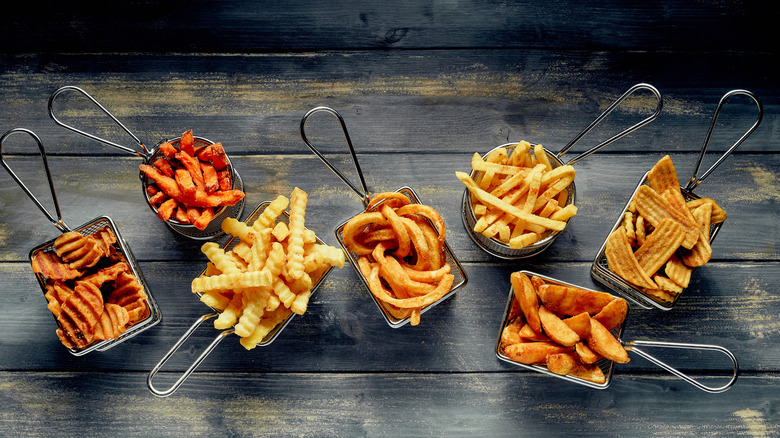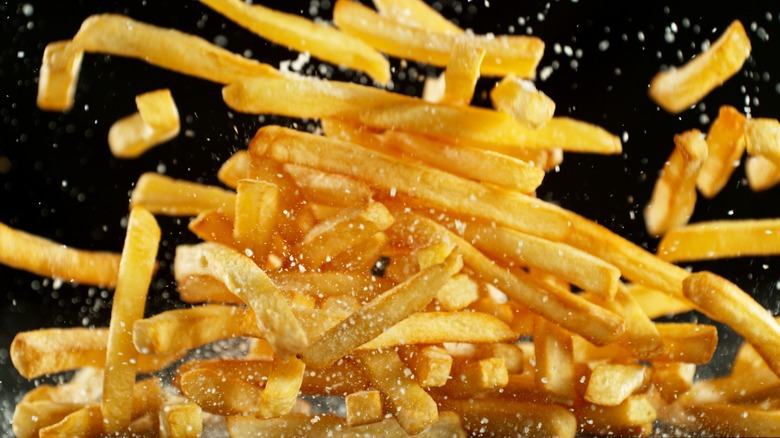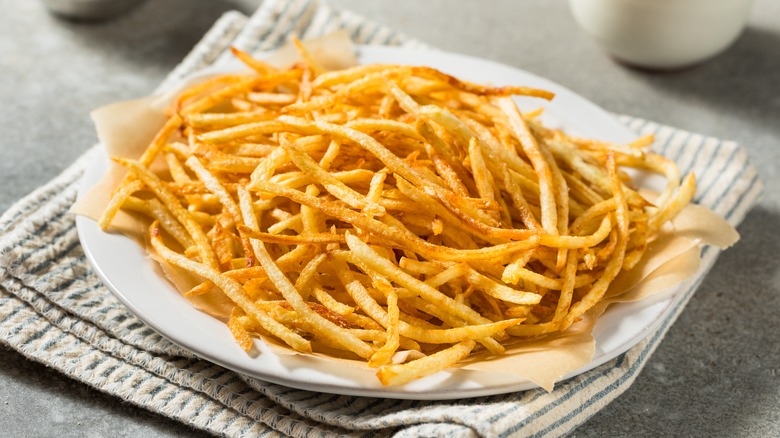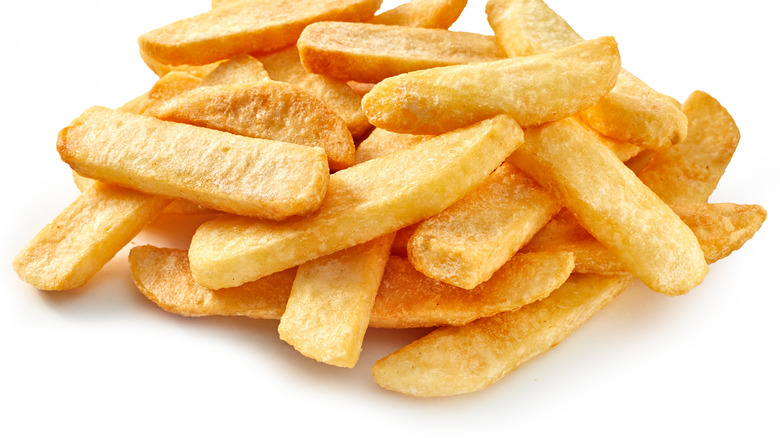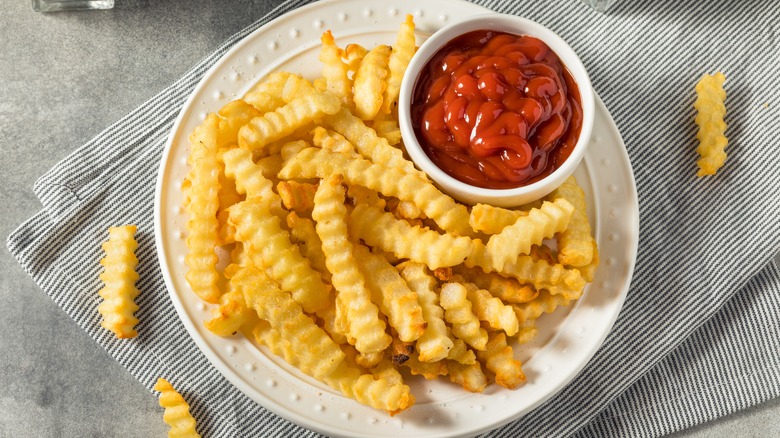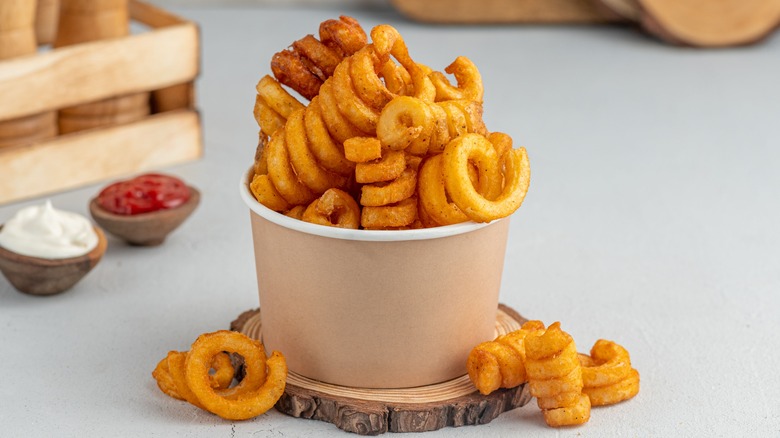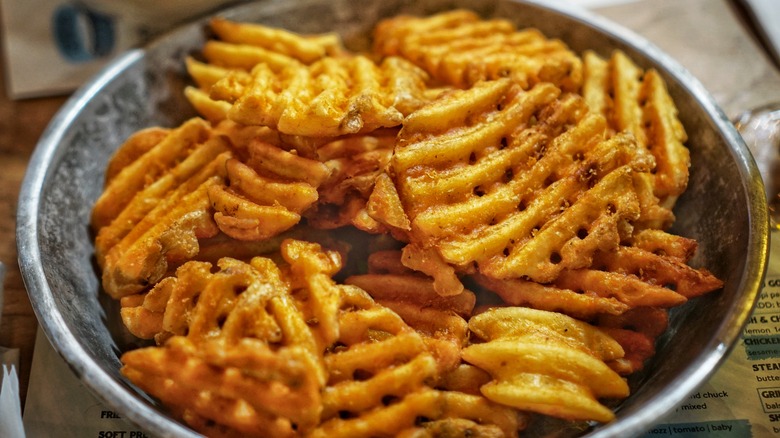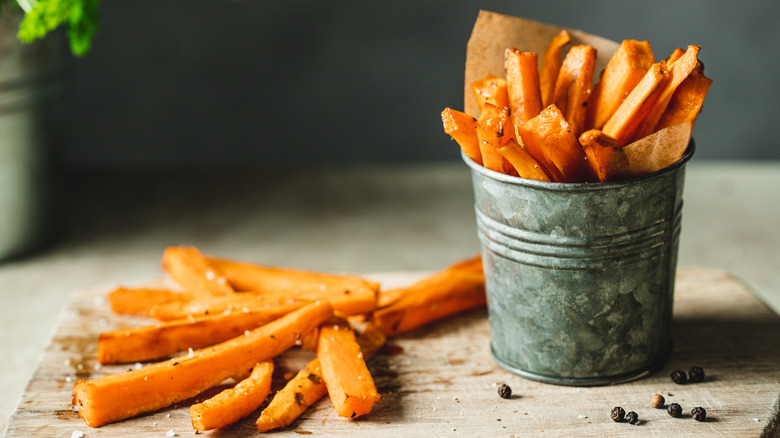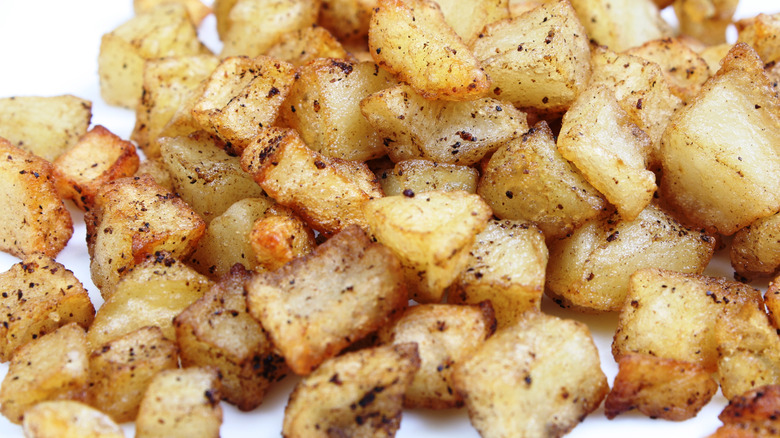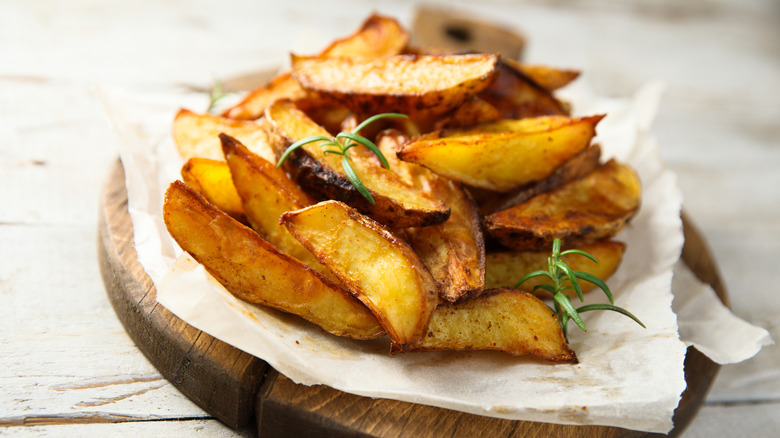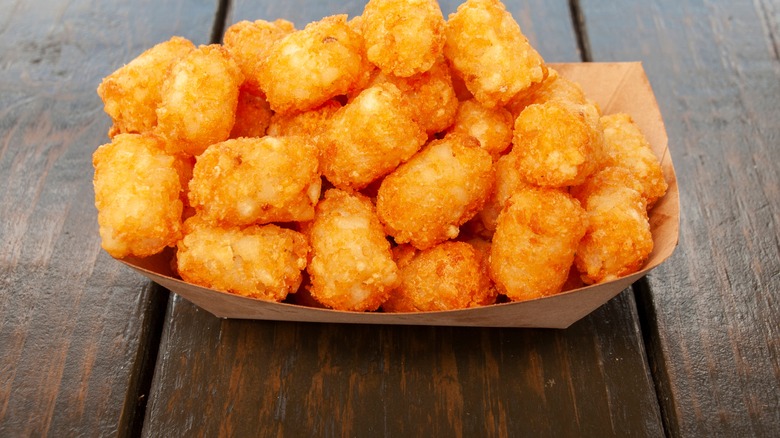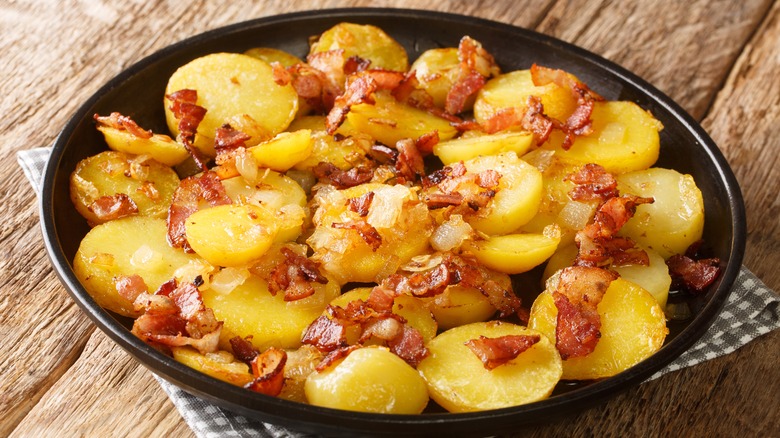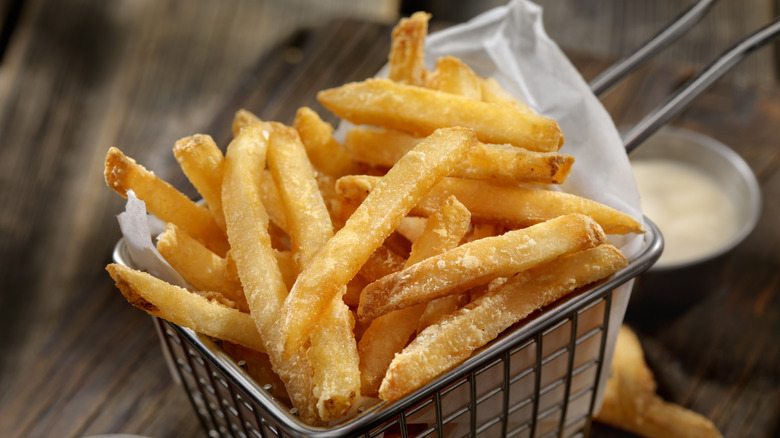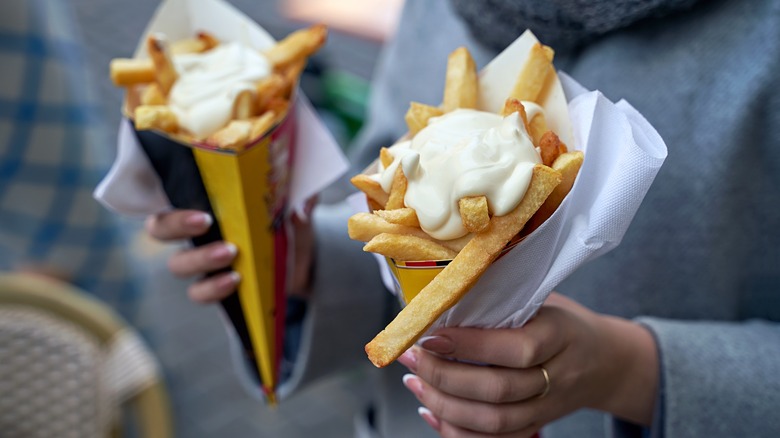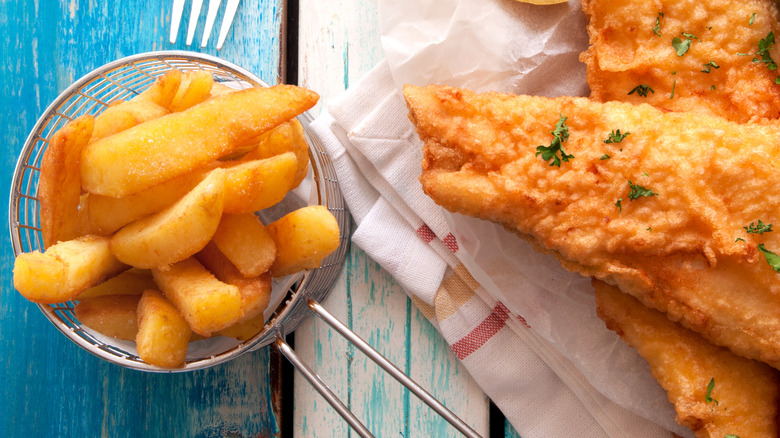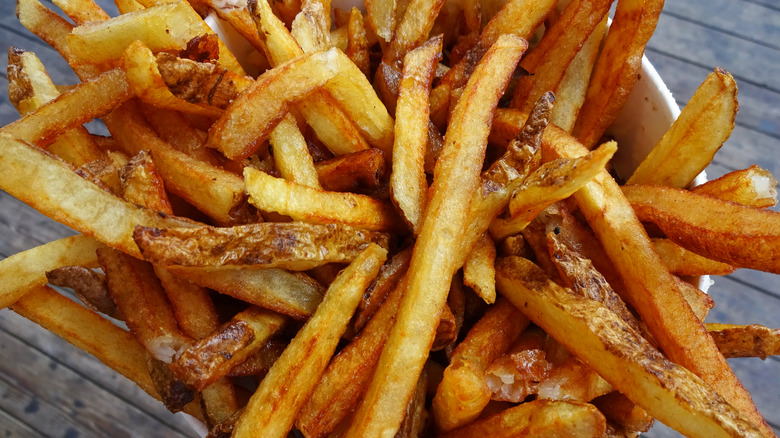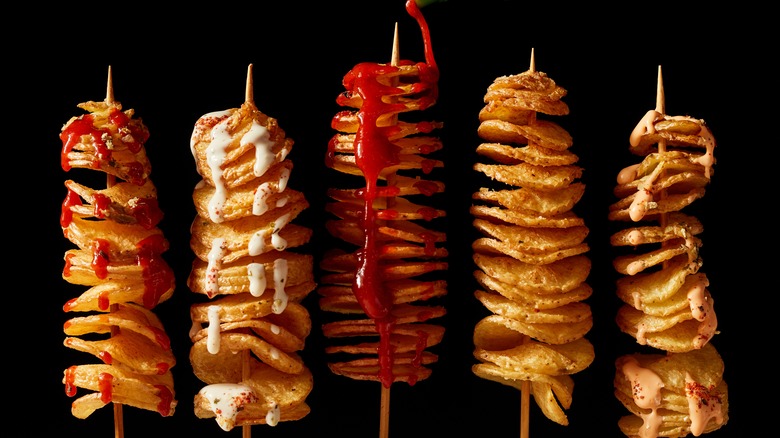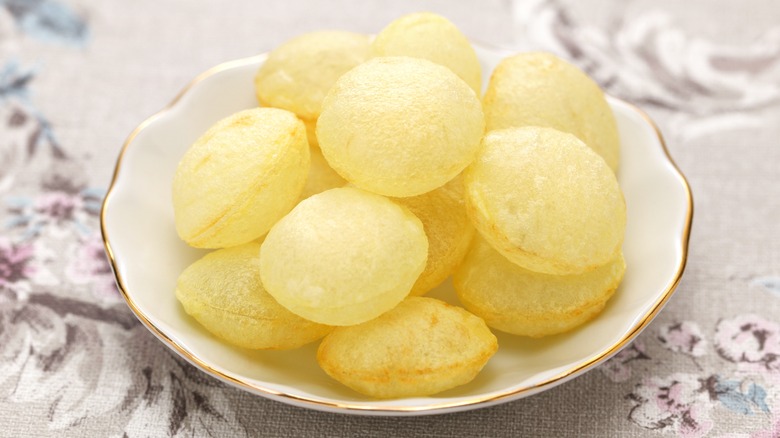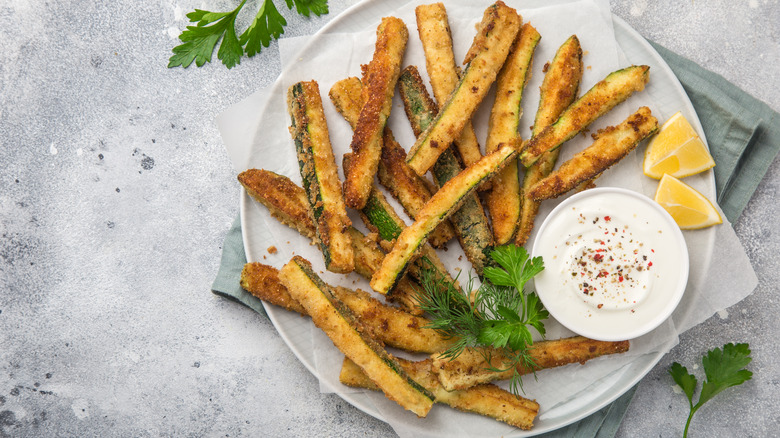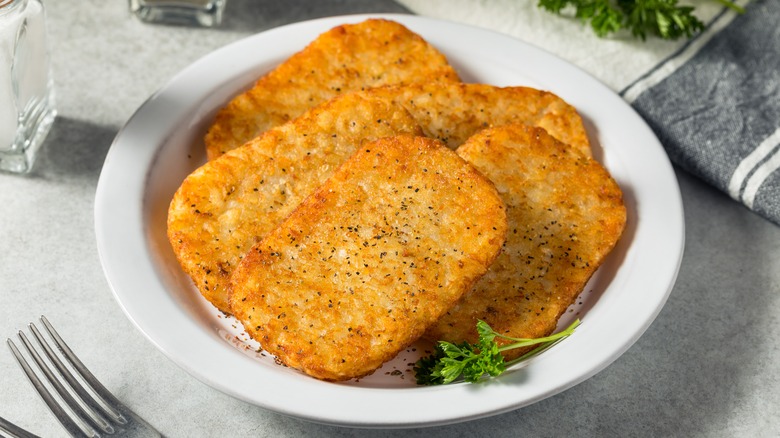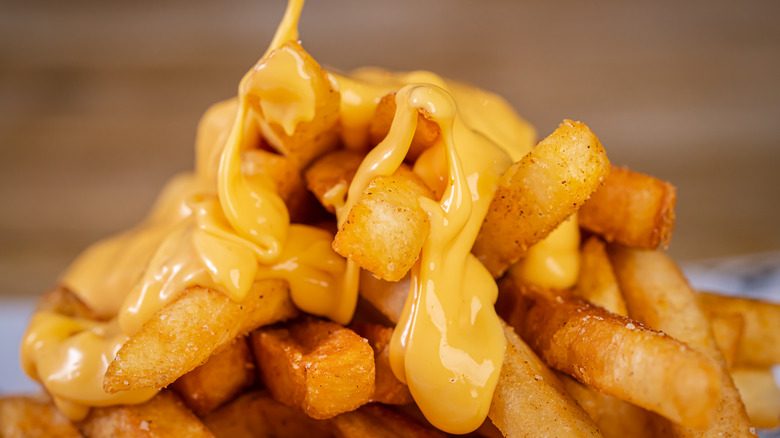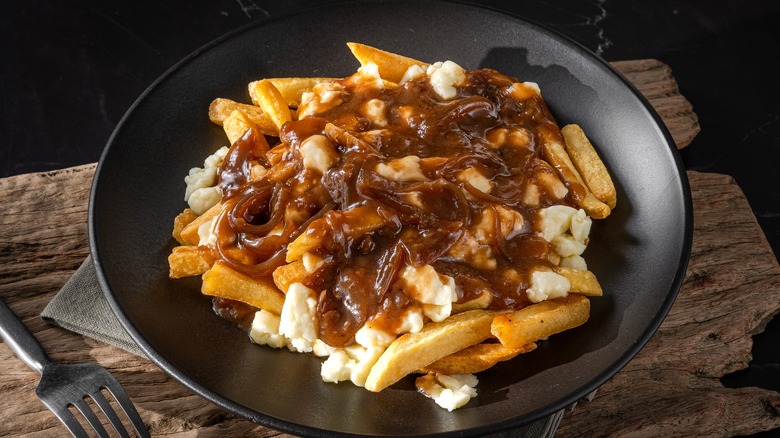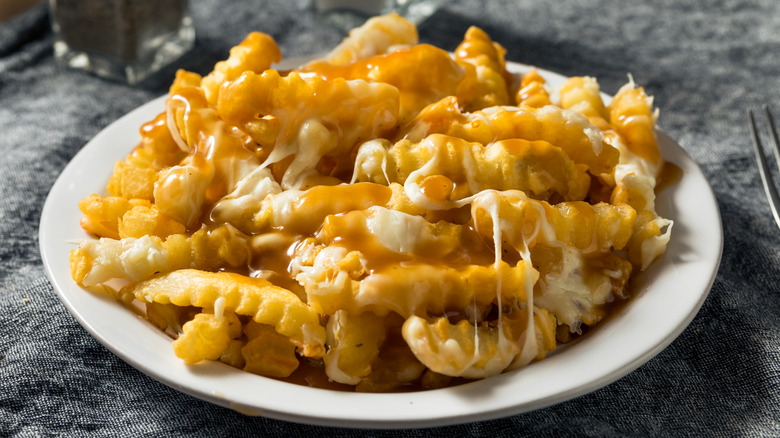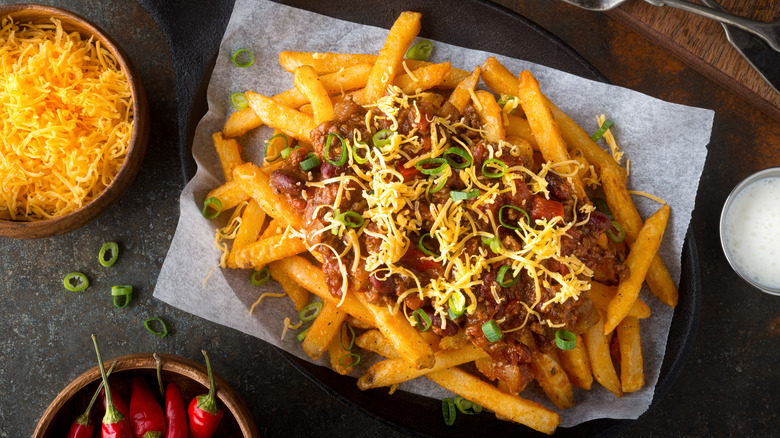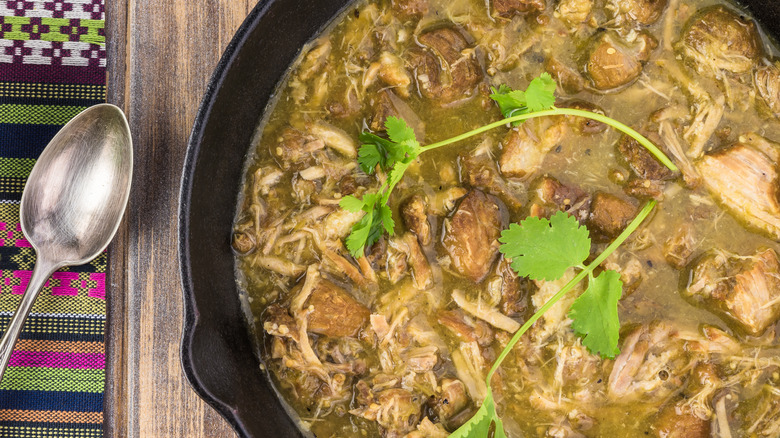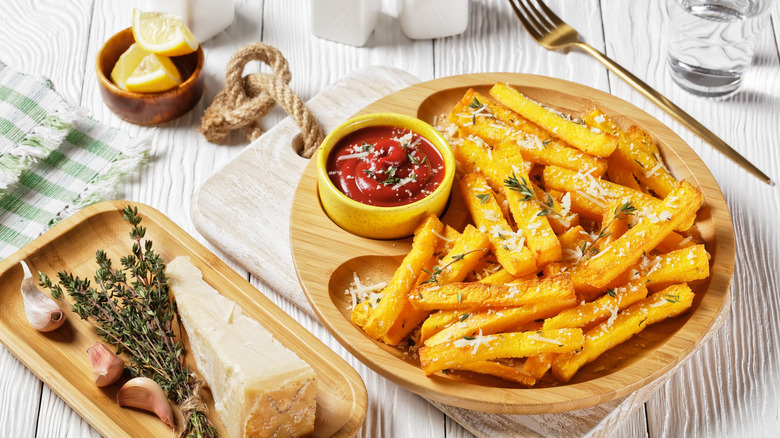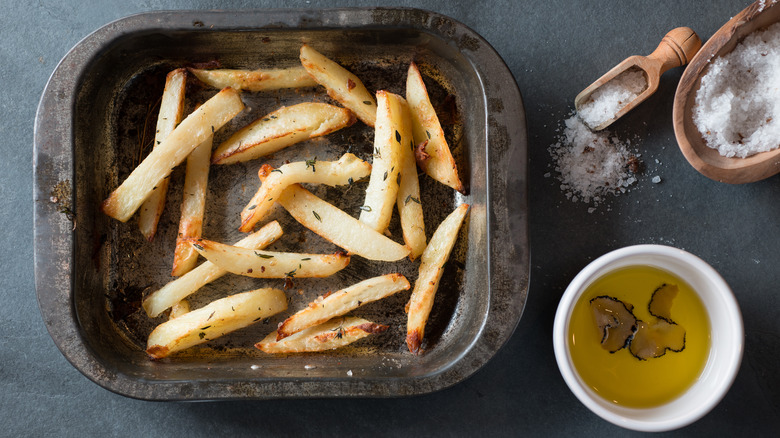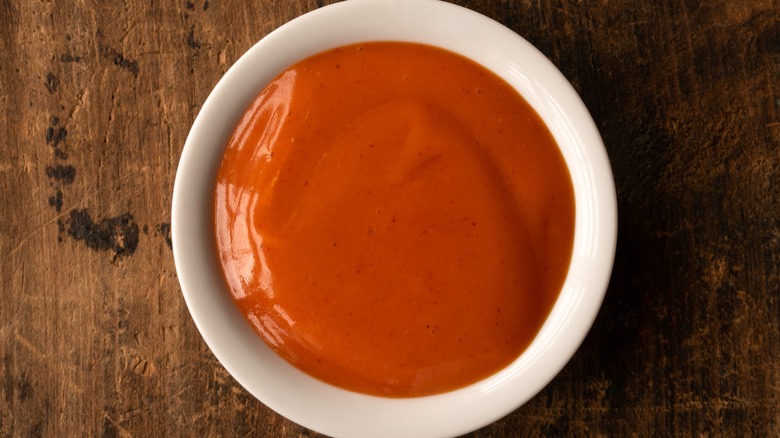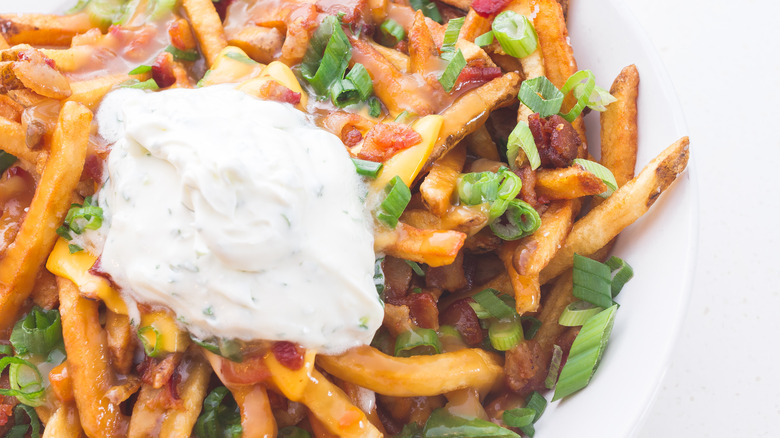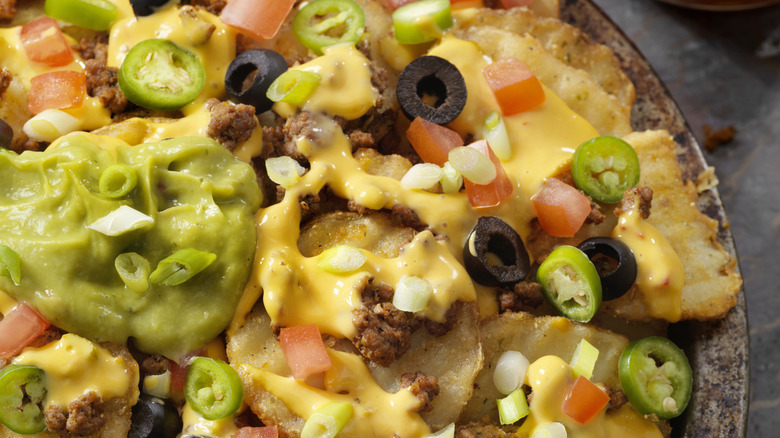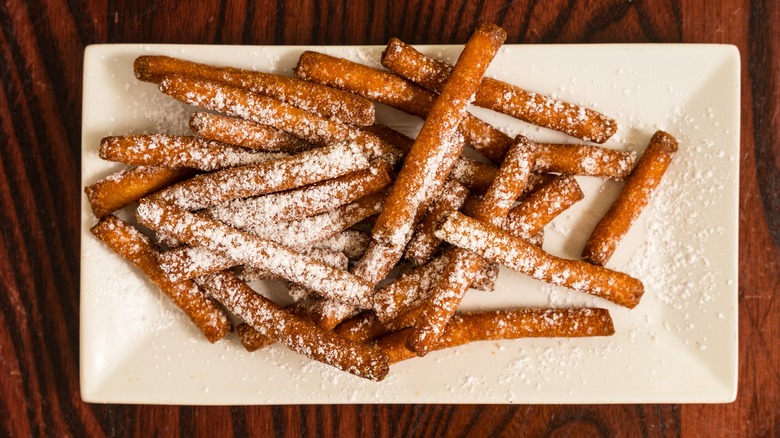30 Different Types Of French Fries Explained
The origins of french fries may be somewhat disputed (are they French or are they Belgian?), but there is no doubt they have left an impressive mark on food culture around the world. Regardless of who invented them, they have become a worldwide sensation, and today, many different drool-worthy varieties have come into existence. While you've probably tasted or at least heard of most types of french fries before, it can be tricky to keep them all straight. From creative toppings to inventive shapes, there's a lot to learn about french fries. Even if you think you already know everything about fries, something tells us there's more to discover.
Like most people, we love french fries. As a result, compiling a list of assorted fries was almost second nature. Still, we researched various ways to cut potatoes, popular recipes, regional favorites, origins, and more to give you an informative collection of variations and a comprehensive understanding of your options. Keep reading to learn about 30 different types of french fries so the next time you're craving a salty, crunchy treat, you pick the perfect fry for the occasion.
Traditional-cut fries
Traditional-cut fries, also known as straight-cut fries, are the ones we all know and love. They are found at fast food chains, most restaurants, and in the freezer aisle at your grocery store. While they vary in length, your typical traditional-cut fry is long and about ⅜ of an inch thick. Their long, skinny shape makes them the perfect size to crisp up on the outside while the inside cooks through yet retains softness.
For most people, traditional-cut fries are what they think of when they imagine the ideal french fry consistency. Not only do they have a delicious feel in your mouth, but they also taste great, thanks to their salty exteriors. They may be pretty basic compared to other options, but they are great for dipping in a variety of sauces and are an easy french fry to make at home.
Shoestring or matchstick fries
Aptly named, shoestring fries are long and thin, just like shoestrings. Typically, potatoes for shoestring fries are cut to be about ⅛ of an inch thick, which is only about a third of the thickness of regular-cut fries. Matchstick fries are basically the same thing but shorter. The thin cut of these fries means they cook really fast. It also means they give you tons of crunch without a lot of soft potato inside. The uniform texture makes them a great garnish, but they can also be enjoyed solo or with dipping sauces.
Making crispy shoestring fries at home is quite rewarding as long as you have the right tools. You'll need a mandoline slicer or a julienne peeler to achieve the precise, thin cut of these fries, but they're well worth the effort. Thanks to their ultra-thin shape, you get a mouthful of crunchy goodness in every bite.
Steak fries
Steak fries feature a much thicker cut than most other types of fries: about ¼ of an inch is standard. Their wide shape fries nicely, creating a thin, crispy shell while leaving lots of pillowy potato inside. They may not be as crunchy as other types of fries, but their hearty cut makes them a perfect complement to thick cuts of meat. Their expansive surface area also soaks up salt and makes them ideal for dipping in various sauces.
You'll find these steak fries at some restaurants and in frozen bags at the grocery store, but you can also make them at home. Cutting large slices of potatoes for steak fries is much easier than other fry cuts. You can quickly achieve the right shape and size with a sharp kitchen knife, but we recommend using an apple slicer to make it virtually effortless.
Crinkle-cut fries
The precisely cut exteriors of crinkle-cut fries may look unique and appealing, but they actually serve more than an aesthetic purpose. Due to the varied cut, these fries have significantly more surface area than regular-cut fries. The signature shape allows them to become extra crispy on the outside, yet also maintain a softer inside, creating the perfect blend of both textures. The crinkly shape also helps you scoop up more dipping sauce in every bite.
Making crinkle-cut fries requires a special device to achieve the signature zig-zag shape. So, unless you're really committed to adding them to your home cooking skills, buying them frozen from the store may be best. Of course, you can always enjoy them at restaurants and popular fast food chains, too. Still, we recommend leaving this one to the pros.
Curly fries
Named for their shape, curly fries are thin, winding fries that resemble curls. They are made with a spiralizer and are cut to be about the same width as traditional fries. Due to the way they are cut, you often wind up with various shapes and sizes and lots of smaller broken pieces, but their form and texture give them lots of eye-catching appeal. However, since they require a special tool to make and quite a bit of effort, it may be best just to grab some from the store.
Most curly fries you buy or find in restaurants are seasoned with a blend of cayenne pepper, garlic powder, onion powder, paprika, and flour. The additional coating gives them a bold flavor profile and an extra crispy exterior. The seasoning is delicious enough that dipping sauces and other condiments are not really necessary.
Waffle fries
As the name suggests, waffle fries look like mini waffles made out of potatoes. They have a crisscross texture with lots of ridges, crevices, and small holes that crisp up beautifully when fried. Their unique shape makes them perfect for holding lots of dipping sauce or toppings so you can achieve the ideal blend of flavors. The distinctive shape of waffle fries also allows them to retain soft insides, even though the outsides get extra crunchy.
Unfortunately, making waffle fries at home isn't the most straightforward task because you'll need a mandoline with the right kind of wavy, ridged blade setting to cut lattice shapes out of your potatoes. If that sounds too labor-intensive, you can always swing by Chick-fil-A for some of their famous waffle fries or grab a bag from the grocery store.
Sweet potato fries
The term sweet potato fries refers to any kind of french fry made from sweet potatoes. They can be standard-cut, crinkle-cut, wedges, or even waffle fries. Regardless of shape, sweet potato fries have a sweet, rich taste that is much more complex than typical fries. The flavor is amazing with just salt or ketchup.
Whether it is because of their distinct flavor or the fact that some think they are healthier, something about them draws diners to sweet potato fries. Not to burst anyone's bubble, but sadly, sweet potato fries don't have many health benefits over regular fries. Sweet potato fries have more vitamin A than regular fries but also have more carbs and calories. Regardless, they are simple to make at home. Their main drawback is that they don't always get as crunchy. However, you can easily fix that and make your sweet potato fries extra crispy with cornstarch.
Home fries
While the name clearly categorizes home fries as fries, they aren't typically deep-fried like other french fries. Instead, they are generally pan-fried. Regardless, think of them like french fries for breakfast, but don't limit yourself to only enjoying them in the morning. Basic home fries can be cut in several different shapes. You'll often find the potatoes cut into small chunks in restaurants, but thin slices are probably the most manageable if you're making them at home.
Home fries are pretty similar to hashbrowns. They are both typically pan-fried, topped with salt and pepper, and, of course, are breakfast favorites. The only real difference is that hashbrowns are shredded, and home fries come in larger potato chunks. As a result, they get exceptionally crispy but still have softer insides, giving you a nice blend of textures.
Potato wedges
Potato wedges are like steak fries but much heartier. They also have more of a wedge shape, obviously. Their oversized shape allows them to crisp up on the exterior while maintaining lots of soft potato in the center. They may not be as crunchy as other fries, but they make up for it by giving you more of a mouthful with every bite. Similar to curly fries, potato wedges are often seasoned, so they pack a flavorful punch.
The meaty shape of potato wedges makes cutting them super simple without any special tools. All you need is a sharp knife or an apple slicer. Potato wedges are also found in many restaurants and are a favorite dish for grocery stores to sell in the hot section of their delis. They can also be found frozen, so you have many options when it comes to enjoying these soft yet crispy potatoes.
Tater tots
Tater tots are small pillowy bites of potato with deliciously crispy shells. Think hashbrowns, but formed into little nuggets of yummy goodness. Their shape makes them ideal for dipping or topping with a world of ingredients to make "tachos." Most people buy their tots from the store, but if you find the homemade version at a restaurant, don't pass up the opportunity to try it.
While it may be hard to imagine a time before tater tots existed, they weren't invented until 1953 by F. Nephi Grigg at Ore-Ida, a brand specializing in potato-based foods. Grigg wanted to repurpose the potato shavings produced by making frozen fries, rather than just selling them as feed for livestock – and he sure succeeded. Today, people love tater tots, tater rounds, and mini tater tots to no end. Interestingly enough, the term tater tot is actually still owned by Ore-Ida.
Cottage fries
Combine waffle and crinkle-cut fries, and you get cottage fries. When made professionally, they have a flat oval shape and ridges across the surface. You can easily make cottage fries at home — they just won't have the ridges. Instead, they'll be kind of like flat, disc-shaped home fries. Their large surface area makes them perfect for holding lots of seasonings, dipping sauces, and an abundance of toppings.
Cottage fries are one of the easiest types of fries to make at home. All you have to do is cut your potatoes into thin slices and fry them up. If you want to skip all the excess oil, you can roast them in the oven. Either way, they crisp up wonderfully and still have a smooth texture on the inside. You don't often see cottage fries at restaurants or sold frozen.
Battered fries
Battered fries come in many shapes and sizes, but they are all dipped in batter to promote an incredibly crunchy, flaky, delicious exterior. Depending on the cut of the potatoes, they can still be soft and pillowy inside, giving you the best of both worlds. Even if you're unfamiliar with battered fries, you've almost certainly encountered battered foods before (like fried fish), so the concept should be recognizable.
There are two schools of thought when it comes to battered fries. The first involves making a simple water-based batter with flour and other seasonings. The second, and arguably more popular batter, is beer-based. A good beer batter recipe is well-loved because it adds a lot of depth to foods. Ales are a top pick for this task. Best of all, you can dip anything you want in your batter once it is made, not just fries.
Belgian fries
Belgian fries look a lot like regular fries, but they have a slightly thicker cut. However, the cut isn't what makes them so delectable. Unlike french fries, Belgian fries are exclusively made with Bintje potatoes, which gives the fries a yellow hue. They are also fried two times, which, paired with their thicker cut, leads to delightfully crunchy outsides and soft insides. Traditionally, Belgian fries were cooked in animal fat, but today, vegetable oil is also common.
Belgian fries are typically served in a paper cone with sauce piled on top. Mayonnaise and ketchup are popular, but you'll often find an array of savory, spicy, and sweet sauces offered as well. Belgian fries are not as easy to find in the United States as they are in Europe, where you'll find specific vendors, food carts, and small shops selling just fries. Still, you can find them in some restaurants.
British chips
If you love an authentic fish and chips recipe, you know what British chips are all about. In the United States, you may have encountered some knockoff versions that use regular American-style french fries, but British chips are actually a bit thicker. They're not potato chips, either, which are called crisps in the United Kingdom.
You can enjoy British chips with any dish you'd order fries with. However, due to their iconic presence in fish and chips, they are often served with lots of salt and vinegar. Thanks to their thicker cut, the soft insides soak up tons of flavor while maintaining fairly crispy on the outside.
Boardwalk fries
Since 1929, Thrasher's french fries, also called boardwalk fries, have ruled the french fry game in Ocean City, Maryland. The concession stand set out to make the best fries around, and many would say they achieved their goal. According to Thrasher's, they use only the best potatoes to make their fries, which they call VIPs (very important potatoes). They also soak their potatoes before running them through a slicer invented by the company, which they claim results in the perfect cut every time.
Once the boardwalk fries are ready, you can purchase them in various-sized paper cups. Don't ask for ketchup, either. Thrasher's fries are served with 100% apple cider vinegar, and the only other thing they offer is Pepsi. Five Guys french fries are also made the Thrasher's way, so if you're not in the mid-Atlantic region, you can still get your fix.
Tornado fries
Tornado fries are originally from Seoul, South Korea, but you won't have to go that far to get a taste of these uniquely shaped fries. In the United States, you'll find them at most state fairs and festivals with food vendors. When you spot them, the first thing you'll notice is their unique spiralized shape. Thanks to a wooden skewer, the long, thin potato cut stays intact, leaving it to crisp up exceptionally well, almost like slightly thicker potato chips.
While it may look challenging, making tornado potatoes at home is easier than you might think. With the help of some wooden skewers, a sharp knife, and a bit of patience, you can spiral your way to a delightful snack in a matter of minutes. Just take your time and make precise, thin cuts — and don't forget to drizzle them with sauces and tasty toppings.
Pommes soufflées
Pommes soufflées are a type of fried potato from France. Potatoes are cut into coin shapes and then pan-fried twice, unlike regular french fries, which are deep-fried. The first fry crisps up the outside of the potatoes. Then, after cooling, the second fry causes the potato coins to puff up into their signature, airy balloon shape.
After cooking, pommes soufflées are delicate puffs of potato goodness that can be seasoned any way you like. Unfortunately, their fragile structure means they aren't really ideal for dipping. However, they can be stuffed to make flavorful renditions like these crispy-creamy za'atar pommes soufflées. You won't find these in many restaurants because they are quite labor-intensive to make, and the margin for error is high. Still, their unique texture makes them worth giving a try.
Zucchini fries
They may not be made from potatoes, but zucchini fries are undeniably delicious. When cooked right, they give you all the same tasty soft and crunchy textures plus a ton of extra flavor and a juicy finish. Conveniently, you can easily make zucchini fries at home, and they taste great with a world of creative sauces — think flavored aioli, marinara, ranch, and more.
Zucchini fries are also more nutritious because they're lower in calories and carbs than potato fries. Of course, once you batter, bread, and fry them, they'll jump up in calories and carbs; but they still give you an extra serving of veggies, so take the win where you can.
Hash brown patties
Hash brown patties are synonymous with breakfast. Similar to tater tots, they are formed to have thin, crispy exteriors and soft insides. However, they come in a patty shape that is round or often rectangular with rounded edges (like a hockey rink). Either way, these yummy potatoes can be found at various fast food chains that serve breakfast, in the freezer aisle of your grocery store, or you can make and pan-fry them yourself.
To avoid a classic mistake when making hash brown patties, make sure to avoid over-manipulating or pressing down on your potatoes while they cook. If you do, they are likely to break up into smaller shredded pieces.
Cheese fries
Gooey, crunchy, and mouth-wateringly delicious, cheese fries are the perfect mix of two things we all know and love: cheese and fries. You can make them with any fries and any cheese, for that matter, too. Traditional-cut fries are the most common base for this tasty dish, but don't limit yourself.
When it comes to the cheese, feel free to play around. But, for the most part, there are two ways to make great cheese fries, and they both involve yellow cheese. The first and easiest method is to sprinkle cheddar cheese on top of the fries and melt it. The second approach is to smother your fries with nacho cheese sauce, which is also exceptionally easy if you buy the sauce premade.
Poutine
Originally from Québec, poutine has since spread its wings and currently holds the title of the national dish of Canada. Poutine consists of thick-cut potato fries topped with savory brown gravy and squeaky cheese curds. The finished product is soft, crunchy, chewy, and delicious beyond belief. It is the perfect dish to enjoy in cold weather, so it's no wonder it's a Canadian classic.
While its traditional format is the standard, poutine can also be made with inventive toppings and sauces, so there is a world of flavor possibilities when it comes to creating this beloved dish. If you haven't tried the original recipe, start with that. However, when you want to experiment, we recommend making buffalo chicken poutine or brisket poutine.
Disco fries
While closely related, disco fries are not to be confused with poutine. They are like poutine, but with an Italian twist. Hailing from New Jersey, disco fries are also topped with gravy and cheese, but instead of squeaky cheese curds, they feature shredded mozzarella. They're typically made with crinkle-cut fries as well, but the rules of disco fries aren't as strict as with poutine. As a result, switching out the type of cheese, gravy, or fry is not forbidden.
The origin of disco fries says they were named for the late-night clubgoers who enjoyed the snack in the 70s, but their delicious flavors and textures ensured they stood the test of time. Today, you don't have to go to New Jersey to enjoy disco fries. You'll find them at plenty of diners and restaurants across the States. Of course, you can always make them at home, too.
Chili cheese fries
As you probably know, chili cheese fries are what you get when you smother a pile of fries with chili and cheese. The result is an array of savory, earthy, zesty, and spicy flavors piled high to bring you a mountain of gooey, crispy goodness.
There aren't any specific guidelines for this dish, other than it must feature chili and cheese on top of french fries. However, cheddar cheese is typical. The chili can be a classic beef chili, a Tennessee white chili, or a vegetarian black bean chili. You can also top your fries with diced onions and tomatoes, sour cream, jalapeños, or green onions to add a burst of fresh flavor.
Green chili cheese fries
Green chili cheese fries are like the southwestern cousin of chili cheese fries. They are both made with cheese, fries, and chili, but the type of chili is wildly different. If you aren't familiar with green chili, it is typically made with roasted green chilies, onion, tomato, flour, and not much else. However, these flavors come together to create an amazing, spicy sauce perfect for smothering things like burritos or, you guessed it, fries. Most green chili recipes contain Pueblo, Hatch, or Poblano chilies, but really, any spicy chili pepper will do.
This french fry variation may not be popular everywhere, but in the West, it's a crowd-pleasing favorite for sure. In addition to the basic ingredients, green chili cheese fries taste delicious topped with sour cream, bacon, fresh tomatoes, lime, guacamole, or cilantro.
Garlic Parmesan fries
There's no mystery here. Garlic Parmesan fries are tossed in just what you'd expect: garlic and Parmesan cheese. They are extremely popular, and it's unlikely you haven't come across these before and loved them. You may be familiar with ballpark-style garlic fries, which have parsley and garlic — but why not add some Parmesan cheese, too, while you're at it?
Many restaurants offer an option to upgrade their fries to include garlic and Parmesan, but you can also recreate this favorite at home anytime. All you have to do is toss all three ingredients in a bowl after the fries are done cooking, and you're good to go.
Truffle fries
Arguably the most decadent french fry variation, truffle fries are rich, flavorful, and often expensive to make. There's really not much to them, but the presence of truffle oil or shaved truffles makes the cost skyrocket. Regardless, truffle adds a deep, earthy, musky flavor that can't be created with any other ingredient.
Aside from the fact that truffle fries elevate regular fries tremendously, one of the best things about them is that they are incredibly easy to make. Simply toss your cooked french fries in truffle oil, and voilà: truffle fries. You can also opt to shave truffles on top, but actual truffles are much harder to acquire than truffle oil, which you can grab at your local grocery store.
Buffalo fries
Buffalo fries may not be as common as many of the other variations on our list, but that doesn't make them any less delicious. To be considered buffalo fries, you just need french fries and buffalo sauce, but there is more than one way to create the dish. You can either toss your fries in buffalo sauce to give them an even coating, or you can top a pile of french fries with chicken tossed in buffalo sauce.
In addition to fries, buffalo sauce, and maybe chicken, buffalo fries taste amazing when topped with blue cheese, Parmesan, and a drizzle of ranch or blue cheese dressing. With additional toppings, they overflow with a tangy, spicy taste and feature a touch of creaminess that subdues some of the heat while simultaneously adding another layer of flavor.
Loaded fries
When you're ready to take your cheese fries to the next level, loaded fries are the obvious solution. Essentially, they are just cheese fries that have extra toppings like bacon, chives, diced tomatoes, and sour cream added to the top. Think of the toppings you would put on a loaded baked potato and just swap out the whole potato for french fries. Now you have loaded fries.
Both cheese sauce and melted shredded cheese work for loaded fries, and the toppings add extra flavor, crunch, and creaminess. Yum! You could even add some sliced jalapeños for a spicy kick.
Nacho fries
Similar to loaded fries but with a twist, nacho fries are more like a meal or appetizer than a side dish. Sometimes referred to as Irish nachos, they are smothered in cheese and topped with pico de gallo, jalapeños, guacamole, beans, various meats, and occasionally black olives. No matter the toppings you choose, the result is a pile of amazing flavors and textures.
Waffle fries are one of the best choices for the base of nacho fries because they allow you to scoop up more tasty toppings, just like chips would. If you haven't tried nacho fries before, this is your sign to make some or seek them out as soon as possible.
Funnel cake fries
Like no other type of fry out there, funnel cake fries are sweet and decadent. Unlike french fries, they aren't made from potatoes. Instead, they are made with funnel cake batter. The reason they are called fries is because of their shape, which resembles regular or thin-cut fries.
Even though funnel cake fries are made with batter and not potatoes, they still feature a super crispy shell. However, the inside is light and airy. Typically, you'll find them topped with powdered sugar, just like funnel cakes, and served alongside sweet condiments, like berry jams, chocolate sauce, caramel, or strawberry purée.

